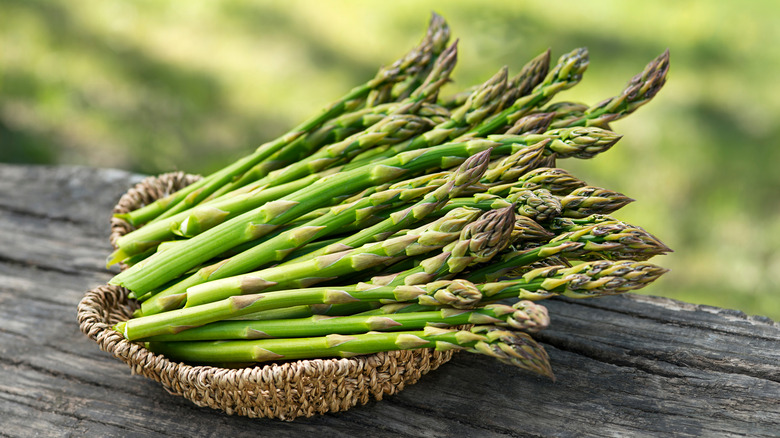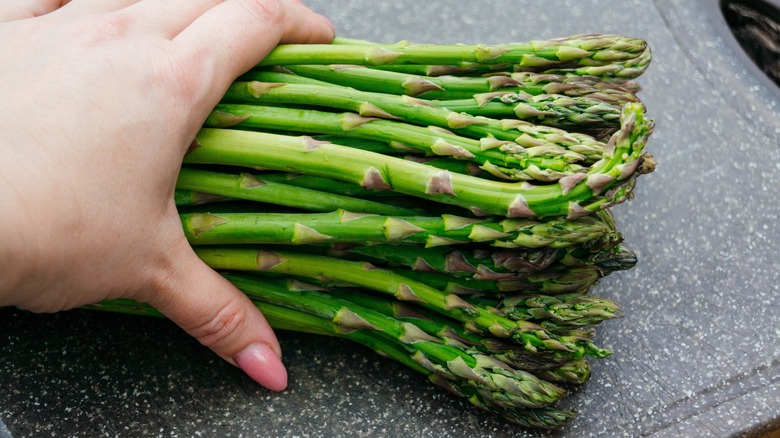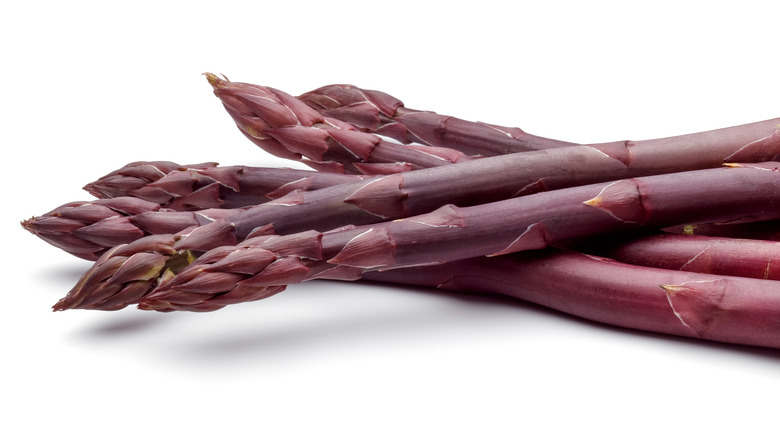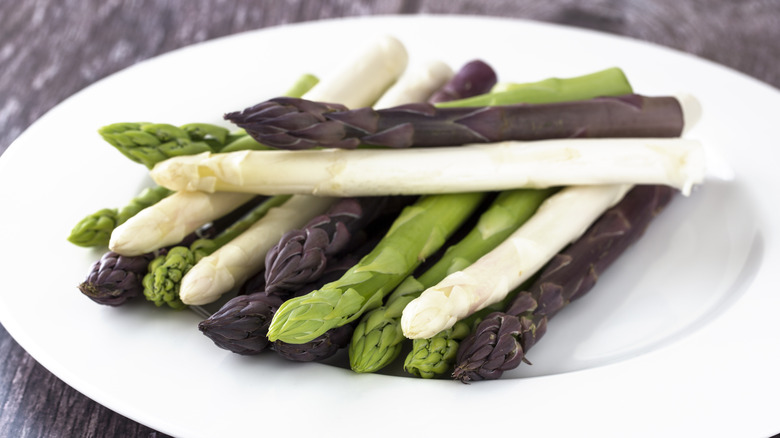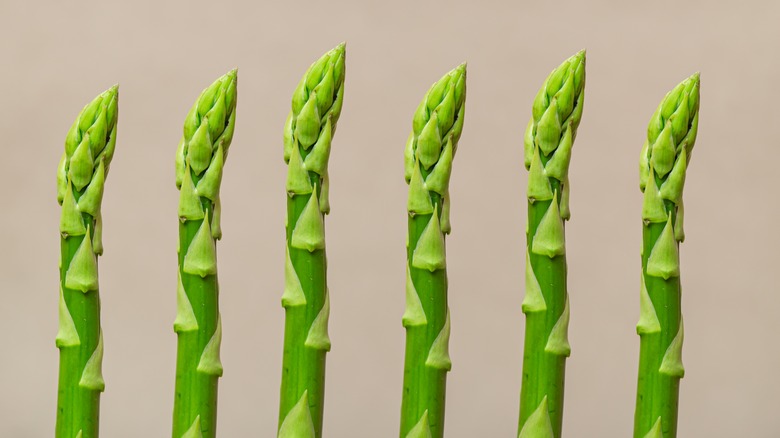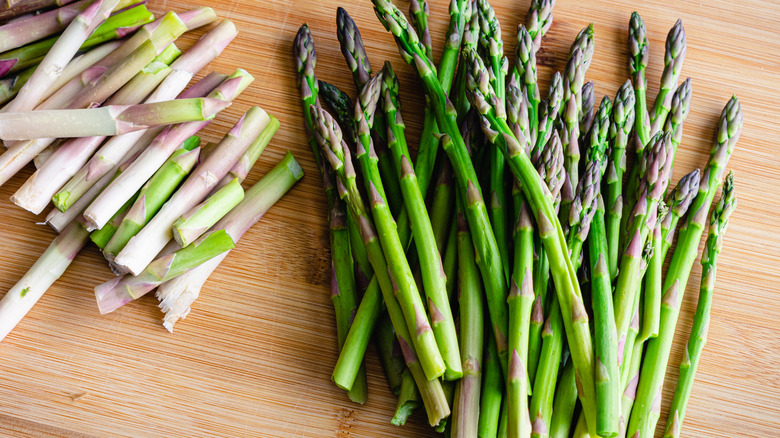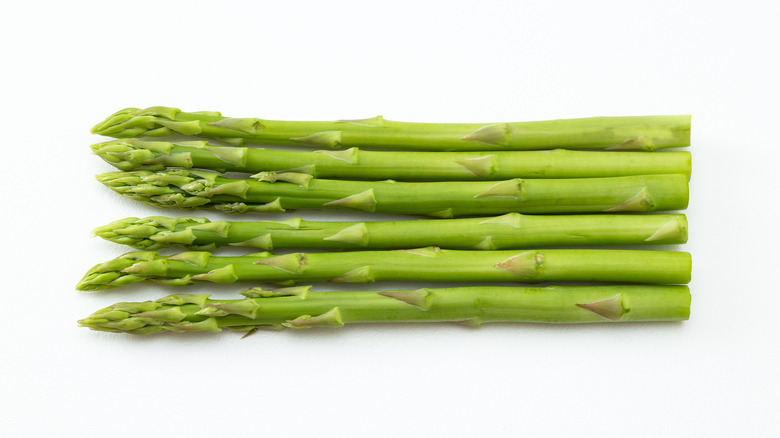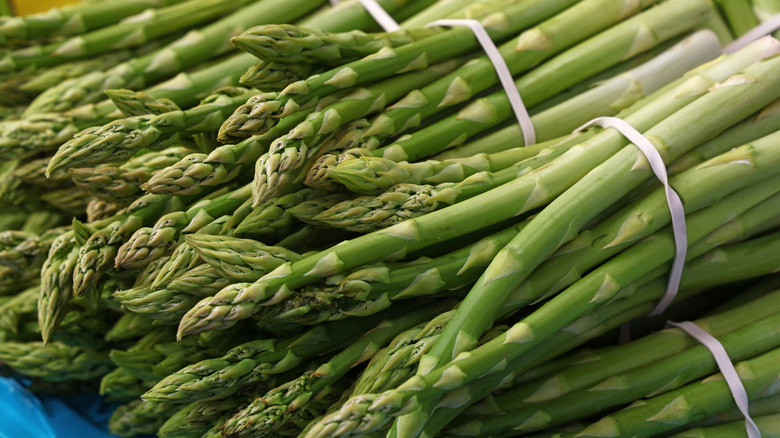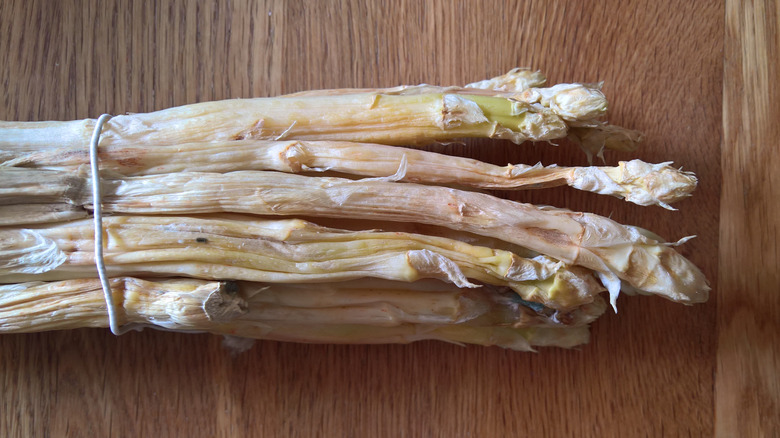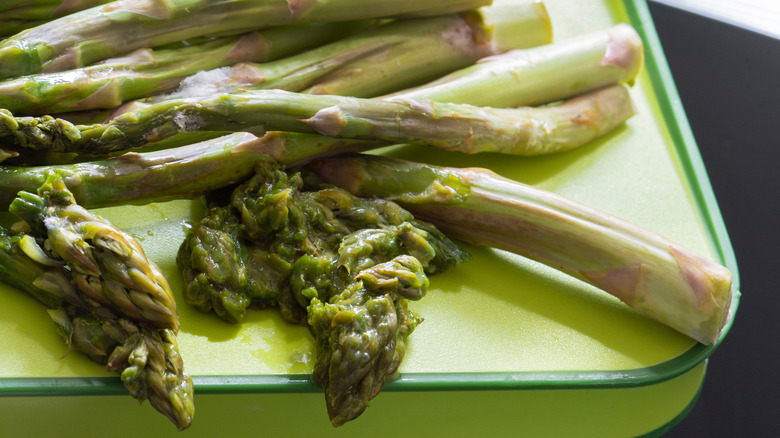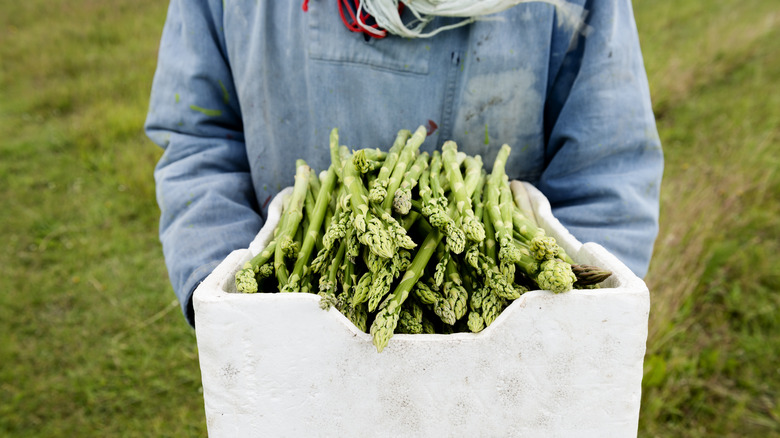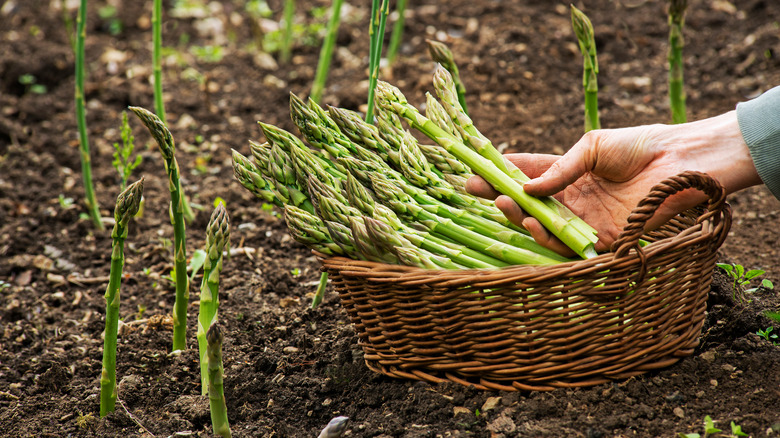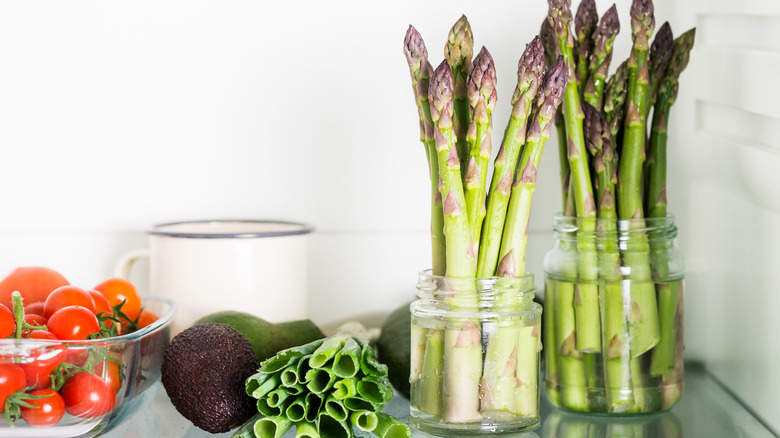What To Look For When Buying Asparagus
Asparagus is a quintessential spring vegetable that brings delicate earthy flavors and a good dose of nutrients to any meal. With slender stalks and vibrant hues, it has a tender bite and subtle sweetness. Renowned for its versatility, asparagus can be grilled, roasted, or stir-fried to add depth and freshness to a variety of dishes. However, not all asparagus is created equal. To make sure you pick a bunch with the ultimate flavor, texture, and freshness, it's crucial to know what to look for when purchasing it.
When navigating the produce section, rows of asparagus might seem identical at first glance. Yet, subtle differences in appearance and texture can signify a variance in taste and quality. Factors such as growing conditions, transportation methods, time since harvest, and how it's been packaged can all affect the vegetable's condition. Join us as we uncover the essential criteria for selecting the finest asparagus, from texture, color, and size, as well as spotting when it's past its best. Armed with this knowledge, you'll be confidently handpicking the best of the bunch. So, let's unlock the secrets to selecting asparagus that promises optimal potential for your cooking needs.
It should have a firm, smooth texture
One of the primary indicators of quality asparagus is its texture. When selecting it at the store, pay close attention to the firmness and smoothness. A firm texture indicates freshness and suggests that the asparagus has been harvested at the right time, preserving its delicate flavor and crispness. To assess the texture of asparagus, start with a visual inspection. The stalks should be rigid when held vertically, without appearing limp or bendy. Check the firmness by giving the stalks a gentle squeeze between your fingers. Fresh asparagus should feel firm, with a slight give but no soft spots or mushiness. Overly soft or rubbery spears may be past their prime.
Furthermore, stalks that are smooth to the touch are a sign of good quality, indicating that the asparagus has been handled with care from farm to store. Rough or uneven textures may suggest poor storage or handling, which can compromise the freshness. At the base, the stalks should appear moist and fresh, instead of hard or woody. Make sure to look out for any signs of wrinkling or shriveling, as this can also mean lack of freshness and deterioration.
Look for vibrant color
The vibrant hue of asparagus not only makes dishes look super appealing but also serves as a useful measure of freshness and flavor. When browsing the asparagus selection, it's always best to choose spears with a bright color. While green asparagus is the most common variety found in grocery stores, you may also encounter purple or white varieties, each offering differences in texture and flavor. Whichever color you go for, look for vibrancy and uniformity, which signals peak ripeness and freshness.
Purple asparagus should display a deep, rich hue, while white asparagus should be ivory-white with no yellowing. When it comes to the classic green spears, they should be vivid in color, though it's normal for them to fade to white or paler green at the bottom of the stalk and have a slight purple hue at the tips. Skip spears that appear dull or discolored, as this typically means they're older and less fresh.
Keep in mind that asparagus may naturally vary in color due to factors such as variety and growing conditions. However, overall consistency across the entire bunch is a great sign. By selecting an asparagus bundle with a uniform, vibrant color, you'll also get maximum flavor.
Choose the right color for your cooking needs
Asparagus can be either green, purple, or white; each variety has a slightly different flavor profile and is best suited to certain cooking purposes. Vibrant green is the classic color associated with asparagus. It gets this distinctive hue from the presence of chlorophyll, which the asparagus produces when it comes into contact with sunlight. Green asparagus is slightly grassy in flavor and contains more vitamins C and A than its purple sibling. This variety is prized for its versatility and can be equally delicious when steamed, roasted, sauteed, or grilled.
Purple asparagus gets its vivid coloring due to the presence of anthocyanins. This variety contains the most sugar and has a sweeter, nuttier taste. It's also naturally more tender than green and white asparagus, making it a great addition to a fresh salad. The longer you cook purple asparagus, the more its eye-catching color fades to green, so quicker cooking methods such as blanching or grilling are better options than boiling if you wish to maintain that vibrancy.
White asparagus is characterized by its pale ivory color. This variety is grown underground and shielded from sunlight to prevent chlorophyll production. As a result, it has a subtle flavor and hint of bitterness. The texture also tends to be more fibrous, typically with thicker spears than green and purple varieties. When it comes to preparing white asparagus, roasting or grilling are great methods for ensuring a tender and flavorful result.
Avoid splayed tips
The delicate tips of asparagus can offer a clear indication of its quality and freshness. When selecting a bundle, take a look at the tips to ensure they are completely closed and firm to the touch. The tips should resemble a compact bud that is vibrant green or purple, which indicates that the spears are at their peak freshness and will deliver optimal flavor and texture when prepared.
Avoid selecting spears with tips that appear splayed or open, which tends to occur in older produce that has been harvested too late or stored for too long. Splayed tips can also result in a less appealing presentation and texture when cooked. Tips that are soft and mushy are another sign of a bundle that's past its best. If they're slimy, starting to brown, or have a foul smell, the asparagus is most definitely spoilt and not suitable for eating.
The stalks should snap easily
A good sign of fresh asparagus is its ability to snap easily when bent. This simple test can help you gauge the crunchiness of the spears, ensuring you select the best quality produce. When you grasp an asparagus spear toward the bottom and apply slight pressure, it should snap cleanly. This indicates that the spear is fresh and at its peak tenderness, ready to be enjoyed in your favorite dishes. On the other hand, if the spear bends without snapping or feels mushy, it's a sign that freshness has declined.
Keep in mind that the snapping test is most reliable for thicker asparagus. Thinner spears can be more flexible and may not snap as easily. Additionally, though snapping off the asparagus ends by hand has long been a popular way to prep it for cooking, some argue that this method is wasteful. Supposedly, when you snap a spear, it should naturally break at the exact point where the tougher end (that you want to discard) meets the tender stalk. However, this is not always the case. The stalk can sometimes break higher than intended, depending on how and where you bend it. To avoid wasting perfectly edible parts of the stalk, trimming off the tougher ends by eye with a knife is recommended.
The stalks should be nicely rounded
For another sign of optimum freshness, check the shape of the asparagus stalks. Rounded stalks are a sign of healthy growth and proper development, and let's face it, noticeable indentation or bulges can be unsightly. The freshest spears should feature uniformly rounded stalks, with no sign of flattening. A stem that is flattened or misshapen in this way can indicate damage or disease. For example, fasciation disease is a genetic mutation that results in asparagus with completely deformed stems. Particularly frosty or windy conditions during growth can also lead to crooked stalks. So, ensure the spears are smooth and cylindrical from tip to base, with a consistent thickness throughout.
For the best dining experience, opt for a bundle with uniform stalks to ensure an even texture, whichever way you choose to cook the asparagus. As well as potentially being less fresh, spears that are irregularly shaped may result in varying degrees of tenderness.
Look for stalks that are uniform in size
Consistency in length and thickness is a key factor to consider when buying asparagus. The best time to harvest the spears is once they've grown between 8 to 10 inches tall, and the stalks are at least half an inch thick. These are helpful measurements to keep in mind when browsing the asparagus selection, though remember there will be some natural variation from farm to farm. The important element to look out for is uniformity within the bunch.
The thicker the stalks, the longer they will take to cook. For example, roasting thin stalks could take 10 minutes, but you might need to double this time for thicker stalks. Consequently, an unevenly sized bundle will be difficult to cook in one big batch. Spears of the same size are easier to prepare, allowing you to trim the ends evenly for a clean, uniform appearance. There's something so satisfying about those spears lining up perfectly on the plate!
Avoid blemished or browned stalks
This one may seem straightforward, but it's certainly one of the most important things to look out for. Fresh asparagus should boast a vibrant, uniform appearance, free from any brown spots or other blemishes. Pristine and unblemished spears will deliver superior flavor, texture, and visual appeal when cooked, so pay close attention when selecting a bunch. Imperfections may not only result in unwanted textures and tastes when cooking but could also be a sign of something worse.
Areas of color change on the stalks and tips, from the usual distinctive green, purple, or white to an unsightly brown or black indicate the asparagus is well past its best. Eating asparagus that has gone bad poses the risk of food poisoning. This can result in some pretty nasty symptoms from stomach pain and fever to diarrhea and vomiting. If the asparagus has a few small blemishes and the rest appears fresh and vibrant, you can trim off these areas and save the rest of the spear. However, if there are significant areas of browning, blackening, or visible mold, it's time to discard the asparagus.
Skip slimy or sticky asparagus
Another indicator that asparagus is not safe to eat is a slimy or sticky texture. This sliminess occurs when the spears have started to decompose, which indicates the presence of potentially harmful bacteria. Not only would slimy spears be pretty unpleasant to eat, but there's also a risk they could make you sick. If the stalks or tips are visibly slimy, mushy, or deteriorating, the asparagus is most probably past saving. A foul odor is another sure sign that it's best to toss.
Bacteria thrive in nutrient and moisture-rich conditions. Veggies like asparagus possess both of these qualities, so bacteria can begin to multiply rapidly in the prime environment they create. Luckily, you can take some steps to prevent spoilage from bacterial growth. According to the USDA, storing food in the fridge at a temperature of 40 degrees Fahrenheit or below can prevent or dramatically slow the growth of harmful bacteria.
It's also best to avoid placing asparagus in sealed bags or containers. This can trap excess moisture which you want to keep to a minimum. Cool, dry conditions are your best bet to prevent unwanted sliminess. Finally, never wash asparagus before putting it in the fridge, as this additional moisture is great for those pesky bacteria.
Check if it's in season
Buying vegetables that are in season is always a great idea. They're fresher, more flavorful, and often cheaper too. There are also environmental benefits to eating seasonally, as less energy is used to grow and transport the produce, meaning a smaller carbon footprint. In-season vegetables are better for your health too. Often, they don't require treatment with pesticides and preservatives, unlike vegetables that need to be kept fresh for a long journey across the globe. Plus, with a much shorter time from the farm to your plate, the asparagus is more likely to be in prime condition and packed with nutrients.
The peak season for asparagus in the Northern Hemisphere is spring, typically around April and May, though it can be harvested as early as February and through to June. Buying it around this time of year is your best bet for finding the freshest, tastiest, most vibrant, and nutrient-rich asparagus for all your cooking needs. Though grocery stores often carry asparagus throughout the year, the quality will be far superior during the peak season. And with the added environmental and economic benefits, buying seasonally is a no-brainer.
Buying organic isn't essential
When it comes to selecting asparagus, you may wonder whether buying organic is necessary. Pesticides can be harmful to human health, and scientists confirm potential links to cancer, issues with the nervous system, and hormonal imbalances. They can also negatively impact wildlife and damage the environment. Organic produce is grown without these harmful pesticides and fertilizers, but is opting for organic asparagus essential?
The Environmental Working Group has tested and devised a list of fruits and vegetables that typically contain the lowest amounts of pesticide residue — the "Clean 15". The good news is that asparagus makes it onto the list. Over 90% of all asparagus tested had no pesticide residue at all. Scientists think this could be due to an enzyme in the asparagus that can break down common pesticides, leaving no residue on the crop after harvest.
If you're concerned about pesticide exposure or prefer to support organic farming practices, organic asparagus is readily available at many grocery and specialty stores. However, it usually comes at a higher price point compared to conventionally grown options.
How to store asparagus
Once you've selected your prime asparagus bundle, proper storage is the best way to maintain its freshness and quality at home. A few simple tricks can ensure your asparagus stays crisp and flavorful for as long as possible.
Firstly, trim the bottom of the stalks to remove any dry or woody ends — about half an inch should be enough. Next, place the trimmed asparagus in a jar or glass filled with cold water and cover everything loosely with a plastic bag to protect it. Make sure the rest of the asparagus stays dry. Remember, you don't want to trap in moisture, as this can lead to bacterial growth and deterioration. The small amount of water in the jar will prevent the stems from drying out so they stay crisp and firm, without creating an environment that is too moist. Then, it's simply a case of placing your asparagus jar in the fridge to maintain freshness.
If you can't find a jar or want to save space in the fridge, another option is to wrap the bottom of the spears in a damp towel and store the asparagus bundle in the vegetable crisper drawer. Here, it will stay at a cooler and more consistent temperature — the best conditions for preserving freshness. For optimum flavor and texture, it's always best to enjoy your asparagus as soon after purchasing as possible, but using these storage methods, it should keep well for up to four days.
